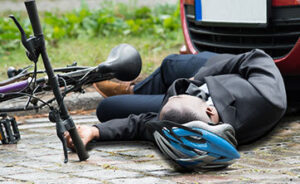 In the situation that bicycling and motor vehicle collision leads to bodily harm, a conventional belief crops up that a cyclist is likely to be at fault. Yet the Available data indicate that the motorists are more likely to be at fault. Bicycle accident deaths represent 2% of all roadway fatalities, the National Highway Traffic Safety Administration (NHTSA) says: However, hospitals collected data reveal that the overall picture of bicycle accidents that caused injury is much bleaker, with only a small portion being reported by the police.
In the situation that bicycling and motor vehicle collision leads to bodily harm, a conventional belief crops up that a cyclist is likely to be at fault. Yet the Available data indicate that the motorists are more likely to be at fault. Bicycle accident deaths represent 2% of all roadway fatalities, the National Highway Traffic Safety Administration (NHTSA) says: However, hospitals collected data reveal that the overall picture of bicycle accidents that caused injury is much bleaker, with only a small portion being reported by the police.
On the basis of the recorded cycling accidents itself, National Safety Council found a growth in 9 percent in the period of 2001 to 2011. Motorist deaths also rose by 9 percent in materialization of the fatalities condition in the course of the realization of the biking activity within the period between 2011 and 2013 where there was a recorded increment in the deaths among bicyclists. In the insurance context, accidents involving bike and auto drivers are termed ‘auto accidents and the injured cyclist can claim for compensation of hospital bills, lost wages and so on. In cases such as in hit-and-run situations or where the motorist to blame or has less insurance, the cyclist can also turn to his or her uninsured/ underinsured auto policy.
Who Are the Bicycle Accident Victims?
Before detailing the frequent causes of bike accident, we must briefly discuss who is most likely to have a bicycle accident. In the website, the NHTSA provides a more comprehensive analysis of bicyclists injured in accidents including how they got injured. Among those most recent findings:
- The average age was 24 in 1988, 32 in 1998, and 44 in 2013, proving that the concept of the ‘children’ riding bikes is a thing of the past in fatal bicyclists’ accidents.
- Of those that were killed, 83% were male Only 17% of those killed were females.
- A breakdown of where bike fatalities occurred showed that most of them, 68%, occurred in urban settings.
- A quarter of all fatal accidents happened between 6 and 9 p. m.
- Thus, in just under one-third of all bicycle crashes at least one of the vehicle’s operators or the bicyclist had a blood alcohol level of 0. 08 g/dL or higher.
Crashes: What Are They? Why Bicycle Crashes Are Happening?
According to an NHTSA National Survey on Bicyclist and Pedestrian Attitudes and Behaviors, the six most common causes of injury to cyclists were:
- Struck by vehicle, automobile or car (30 percent)
- Fell (17 percent)
- 13 percent of roadway is not in good repair
- Horse related accidents resulted from rider error at 13 percent
- Crash/ collision with a fixed object (7 percent)
- Dog ran out (4 percent).
To Whom One Can Blame for Bicycle Accidents?
The Police Department of the US monitor behavioral characteristics of the parties involved in bicycle accident that provides additional knowledge on accident causes. These include:
- 18 percent – driver did not notice cyclist
- 24 percent – cyclist spent a traffic signal that also turned red or did not include for a stop sign.
- 22 percent – driver or passenger opened a car door into an oncoming cyclist
At times, it can be due to a single cause while in some instances; there are multiple reasons that result to bicycle accident. A professional injury lawyer can always consider the possibility of seeking for damages any time regardless or complete or partial blame.